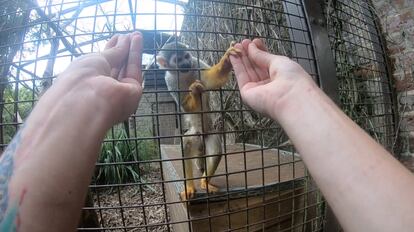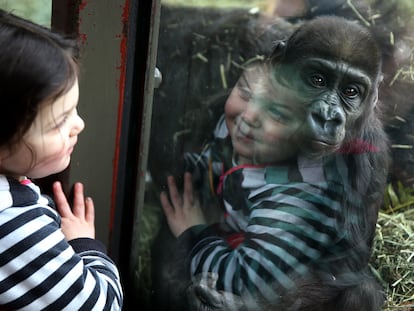Can monkeys be fooled by magic tricks?
A new study indicates that they can, but only when they share the magician’s motor skills

The Barcelona doctor Elías García-Pelegrín has managed to incorporate into his investigative work his two greatest obsessions: magic and animal cognition. According to him, the dichotomy between the arts and sciences does not make much sense. Artists seek to explore the human condition, just like psychologists and biologists, with the difference that the former use empirical methods.
Specifically, magicians need to understand humans’ attention and perception in order to trick their audiences. Magic tricks can tell us a lot about our consciousness and how we perceive reality. Currently, García-Pelegrín is a professor of Animal Behavior at the National University of Singapore, and he is interested in using magic to understand how other animals perceive the world.
He recently published a curious study, which he conducted during his doctoral work at Cambridge University. He offers evidence that monkeys, like us, can also be fooled by magic tricks, but only when they share the magician’s motor skills —that is, when they can conduct the same movements.
In the study, he conducted one of the first magic tricks that any magician learns: the French drop. The magician shows a coin in one hand and then passes the other hand in front of it, hiding the thumb behind their fingers. The human audience, however, knows that the thumb is ready to grab the coin once it is no longer visible. The surprise occurs when the magician separates their hands and opens them, revealing that the coin remains in the first hand.
García-Pelegrín performed the trick before an unusual audience. The subjects were 24 monkeys of three different species: eight capuchins, eight spider monkeys and eight titi monkeys. Instead of a coin, he used a small piece of food. If the monkeys guessed what hand the food was in, they got to eat it.
The selection of the three species was deliberate: capuchins are known for their high manual abilities. The shape of their hands allow them to control each finger individually and grab with precision using their thumb and forefinger. In the wild, they use their dexterous hands to crack nuts with stone tools. The capuchins in the study fell into the trap of the French drop 81% of the time. The trick had a similar effect on them as on a human audience.
Sleight-of-hand #magic trick known as the “French drop”—whose deception relies on opposable thumb movement—only fools monkeys with opposable thumbs. @EGarciaPelegrin, @Dr_RMiller, @CliveWilkins6, @nickyclayton22
— Cell Press (@CellPressNews) April 4, 2023
Learn more in @CurrentBiology: https://t.co/iZJwnpBS0C pic.twitter.com/10coNf3oAh
Spider monkeys are less dexterous than capuchins. Their thumb rotation is limited, but they can still move it to touch the forefinger, to a certain point. On rare occasions, they have been observed using rudimentary tools. They fell for the trick 93% of the time.
Titi monkeys are unlike the others, as they do not have opposable thumbs and cannot grab with precision. They are very small primates whose hands have evolved to allow them to climb up vertical trunks. In this context, it is more useful for them to extend their five fingers to increase their hands’ surface areas, sinking all their nails into the tree at once. Curiously, the magic trick did not work on them: they selected the hand that simulated the grab only 6% of the time.
Thumbs or brains?
The results could be due not to differences in the monkey’s hands, but to other factors such as body size or cognitive capacity. The researchers invented a new version of the French drop, which they called the “Power Drop.” The trick is the same, except that the magician uses the fist, not the thumb, to grab, flexing the rest of the fingers.
In this case, the titi monkeys fell for the magic trick just like the capuchins and spider monkeys. The gesture that the magician makes with the trick is familiar to the titis, as they use it frequently to grab food. The difference between the two tricks is subtle, but it seems to have radically different effects on the titis’ brains.
In an earlier study, García-Pelegrín did the French drop before the attentive gaze of an Eurasian jay, which does not even have hands. As with the titis, the trick did not work. Why could that be? Why do tricks only work when the observer knows from experience the magicians’ gestures?
The magic of mirror neurons
We can find the answer in so-called “mirror neurons.” Neuroscience has given evidence that the motor neurons that are activated when we do an action are also activated when we see someone else doing the same movements.
For example, if we see a dog eat, the neurons in charge of our jaw movements start working. However, they do not activate when we see dogs bark, as the action is not part of our motor repertoire.
Scientists like Guiacomo Rizzolatti, who discovered mirror neurons, have suggested that thanks to them, we can interpret other peoples’ actions. That is, we understand the actions of others when they resonate with our motor neurons. That would make it more difficult for us to decipher movements that we cannot do.
Of course, García-Pelegrín’s study gives evidence that an individual’s motor skills affect how they perceive and interpret other people’s movements. With the French drop trick, the titi monkey did not think that the magician was grabbing the coin with his thumb, despite being familiar with human hands. It is possible that, as they do not have the same ability, their motor neurons did not activate and therefore they could not interpret the movement.
That is just a hypothesis, however, as the function of motor neurons is still debated in the scientific community. There remains a lot of work to do for scientists to understand how animals perceive and process others’ actions. Perhaps what scientific research needs is a little more magic.
Sign up for our weekly newsletter to get more English-language news coverage from EL PAÍS USA Edition
Tu suscripción se está usando en otro dispositivo
¿Quieres añadir otro usuario a tu suscripción?
Si continúas leyendo en este dispositivo, no se podrá leer en el otro.
FlechaTu suscripción se está usando en otro dispositivo y solo puedes acceder a EL PAÍS desde un dispositivo a la vez.
Si quieres compartir tu cuenta, cambia tu suscripción a la modalidad Premium, así podrás añadir otro usuario. Cada uno accederá con su propia cuenta de email, lo que os permitirá personalizar vuestra experiencia en EL PAÍS.
¿Tienes una suscripción de empresa? Accede aquí para contratar más cuentas.
En el caso de no saber quién está usando tu cuenta, te recomendamos cambiar tu contraseña aquí.
Si decides continuar compartiendo tu cuenta, este mensaje se mostrará en tu dispositivo y en el de la otra persona que está usando tu cuenta de forma indefinida, afectando a tu experiencia de lectura. Puedes consultar aquí los términos y condiciones de la suscripción digital.
More information
Archived In
Últimas noticias
Aquilino Gonell, former Capitol sergeant: ‘If it hadn’t been for the police, the US would be a dictatorship’
A hybrid building: Soccer pitch, housing, and a shopping mall
Europe urges Trump to respect Greenland following annexation threats
Science seeks keys to human longevity in the genetic mixing of Brazilian supercentenarians
Most viewed
- Alain Aspect, Nobel laureate in physics: ‘Einstein was so smart that he would have had to recognize quantum entanglement’
- Mexico’s missing people crisis casts a shadow over World Cup venue
- Alvin Hellerstein, a 92-year-old judge appointed by Bill Clinton, to preside over Maduro’s trial in New York
- Why oil has been at the center of Venezuela-US conflicts for decades
- Cuba confirms death of 32 of its citizens in the US attack against Venezuela











































